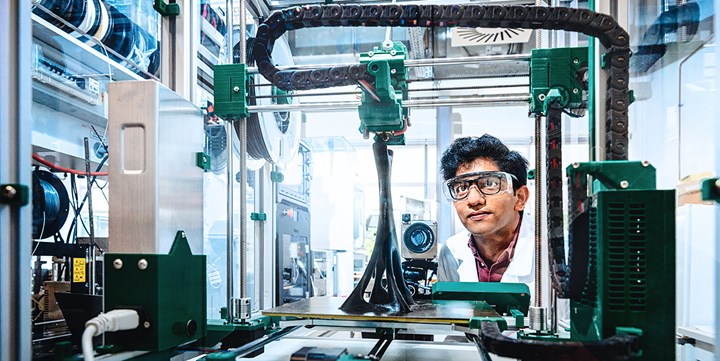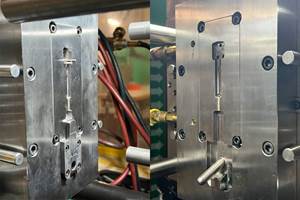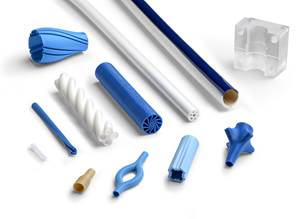Printed Polymers that Change Shape Once in a Predefined Way When Heated?
Fraunhofer’s new 4D Printing technology can shrink printed objects up to 63%.
Thanks to a 4D printing technology developed in the Fraunhofer Cluster of Excellence Programmable Materials CPM, printed polymers change shape once in a predefined way when heated. The extent of the change in shape of the printed objects is drastic: they can shrink by up to 63%. Fraunhofer researchers anticipate that in the future, 4D manufacturing technologies could be used to produce parts that exhibit a specific behavior only after they take their predefined shape, for example as fasteners in the assembly of components in the medical technology, mechanical engineering, automotive and aviation industries.
Now said to be in vogue, 4D printing as an additive manufacturing technology reportedly offers numerous advantages. For example, products and prototypes can be individually designed and are quickly available. A team of researchers at Fraunhofer CPM is significantly expanding the benefits by producing printed objects using so-called 4D printing. This technology adds the dimension of time, or 1D, to the dimension of space, or 3D. In this way, objects can be printed from shape memory polymers that can change their shape once at a later point in time when exposed to heat - and in quite a remarkable way: rod-shaped samples measuring around four centimeters in length shrink by up to 63%.

Specific curvatures are also possible in a targeted manner. Said Thorsten Pretsch from the Fraunhofer Institute for Applied Polymer Research IAP, who is coordinating the project at Fraunhofer CPM, “We initially started with a relatively simple rod geometry, but ultimately we were able to produce more complex hollow cylinders and hollow cuboid-shaped samples. For all the geometries we investigated, we specified the desired material behavior in advance.”
There are generally two ways to adjust the response to a temperature increase. The first is the choice of material – in this case, the researchers developed a new TPU, with shape memory properties. The team also showed that the findings gained of 4D printing can also be transferred to another thermoplastic polymer: they produced shrinkable printed objects from bio-based PLA. The second possibility lies in the clever management of the printing process. “The key is that we give the materials very little time to cool down during printing. As a result, drastic internal stresses are stored in the material. The subsequent shrinkage effect is then very pronounced,” says Pretsch. In short, the choice of material, processing temperature and printing speed can be used to adjust not only the shrinkage behavior, but also the curved state.
The first step in the project was to develop the material and transfer the findings from TPU to PLA. The second step was to develop a demonstrator - a door opener that is shrunk onto a door handle so that it can be operated with the elbow without hand contact. Disassembly is simple: by reheating; the door opener detaches from the handle without leaving any residue. When the print object is no longer needed, it can be ground and reprocessed into filament that can be used at least one more time for 4D printing. “The concept is holistic and future-oriented. In terms of a cradle-to-cradle approach, we have gone through the entire product cycle – from the selection of monomers and polymer synthesis to the 4D printing of a demonstrator and its mechanical recycling,” Pretsch summarizes.
The four Fraunhofer institutes contributed their specific expertise: the Fraunhofer IAP synthesized the shape memory polymer, further developed the 4D printing technology and carried out the mechanical recycling. Linda Weisheit from the Fraunhofer Institute for Machine Tools and Forming Technology IWU developed the concept of programmable stiffness of the 4D materials. The Fraunhofer Institute for Industrial Mathematics ITWM conducted mathematical simulations to design the demonstrator. “For example, we investigated how the force is distributed in the door opener when it is loaded. We were also interested in finding out which design is better in terms of material consumption,” explains Heiko Andrä. The practical tests took place at the Fraunhofer Institute for Mechanics of Materials IWM. “Here, for example, the question was which torques occur when the door opener is loaded,” explains Tobias Amann.
Related Content
Business Slowing? There's Still Plenty of Stuff to Do
There are things you may have put off when you were occupied with shipping parts to customers. Maybe it’s time to put some of them on the front burner.
Read More3D Printing of Injection Molds Flows in a New Direction
Hybrids of additive manufacturing and CNC machining can shorten tooling turnaround times.
Read More420 Stainless Steel Now Qualified With TrueShape 3D Printing Technology
NPE2024: Mantle's additive manufacturing technology is designed for precision tooling.
Read MoreDuPont Buys Medical Product Manufacturer Spectrum Plastics
Purchase price of $1.75 billion for leading supplier of extruded, molded, and 3D printed medical components.
Read MoreRead Next
See Recyclers Close the Loop on Trade Show Production Scrap at NPE2024
A collaboration between show organizer PLASTICS, recycler CPR and size reduction experts WEIMA and Conair recovered and recycled all production scrap at NPE2024.
Read MoreFor PLASTICS' CEO Seaholm, NPE to Shine Light on Sustainability Successes
With advocacy, communication and sustainability as three main pillars, Seaholm leads a trade association to NPE that ‘is more active today than we have ever been.’
Read More





















